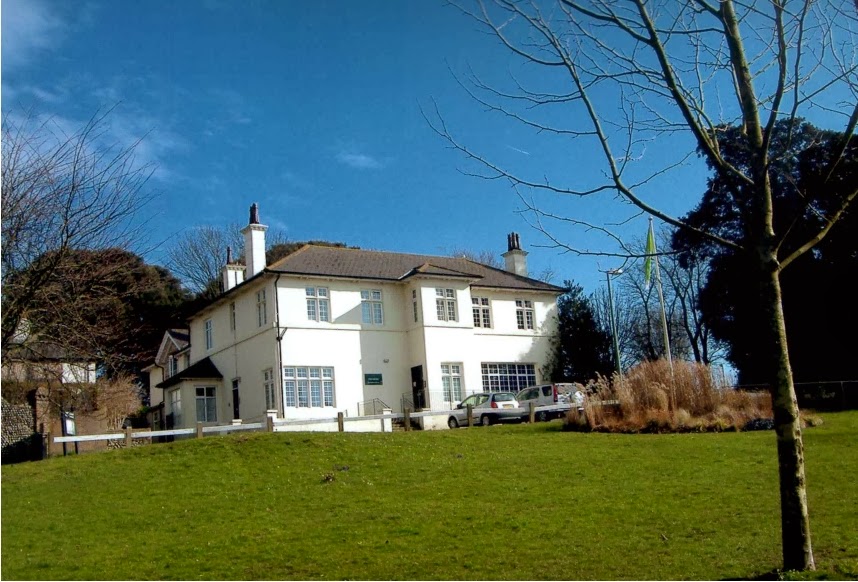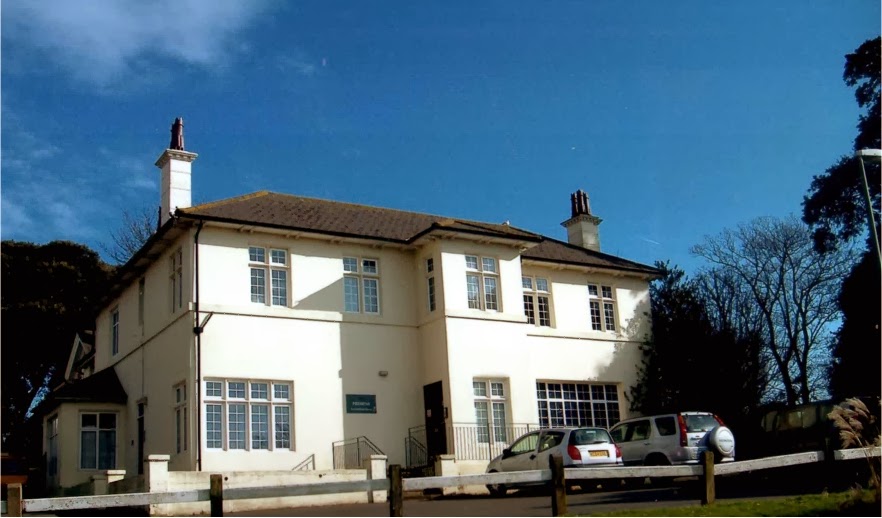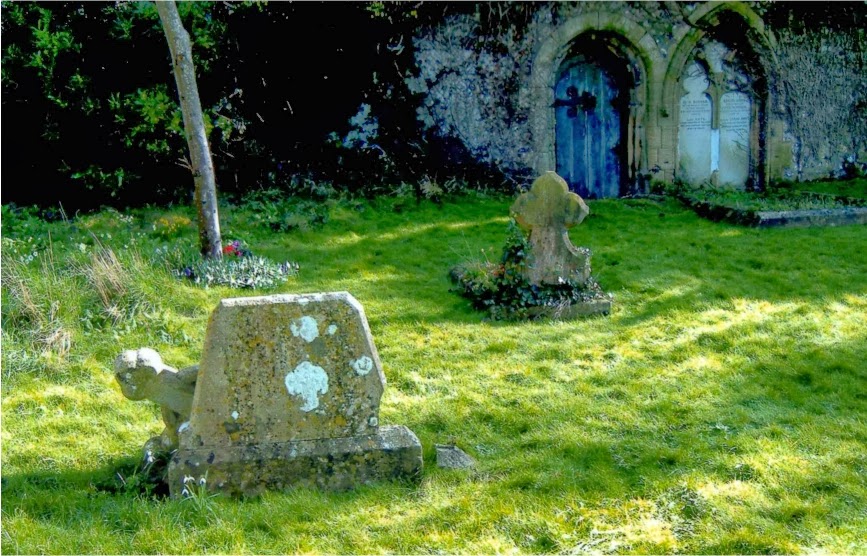It is usually stated that Edward Blaker built the house in around 1848. But looking carefully at the building, it seems obvious that a new imposing structure facing west across the valley was added to an old house already in existence, which may date back to the 17th century. It is also a fact that Edward Blaker once lived in Churchfield House, which was known to be in the vicinity.
An interesting fact has been handed down in Blaker family lore that the old dwelling had the unusual name of Flagbrick Cottage.
The old part of the house is
still to be seen on the north side and east sides, built of flints like
cottages in Portslade Old Village. The oldest flint work is on the ground floor
while the flint work in the upper storey of the north side is of a later date
with red brick string-courses. Indeed, Easthill House and its environs could
almost be an object lesson in the different kinds of flint work. On the north
side there is a walled garden that was formerly the kitchen garden. The wall
was constructed using whole pebbles laid horizontally.
The flint work in the stable block at the back is different again. It is formal with the flints being separated by ridges of mortar moulded to their shapes. The same style can be seen in the wall at Foredown Hospital built in 1883 and in Cemetery Lodge built in 1894 (now numbered 37 Trafalgar Road).
In the entry for Portslade in the Post Office Directory for Sussex 1862 it was stated ‘Manor House … and East Hill are mansions commanding extensive views over sea and land.’
Edward Blaker (1821-1883)
He was born at Brighton, the eldest son of Edward Blaker
of Brighton and Portslade (a grocer by trade) and Anna Kemp, daughter of John
Marchant.
Edward Blaker married twice and
was the father of twelve children, six by each wife. His first wife was Ellen,
daughter of Thomas Isaacson, and their children were Edward, Charles, Thomas
Frederick and Walter (each with Isaacson as part of their names) plus Edith
Ellen and Elizabeth Jane. Thomas Frederick Isaacson Blaker was born at Easthill
House in 1850 and like his great-uncle Harry he too became a surgeon. Walter
became a priest and was vicar of Easterton, Wiltshire. Mrs Blaker died on 28
May 1856 aged 28 years; it was fifteen months after the birth of her last child
and so it was unlikely there was a connection but all the same she had given
birth to six babies in six years with two separate births in 1850.
Edward Blaker then married Emma
Diana, daughter of Robert Lewis, and she was a year younger than his first
wife. Their children were Emma Mary, Edward Spenser, Katherine, Alice, Ethel
Anna and Isabella Maud.
Out of all this brood, two
children died young; they were Edward Isaacson and Emma Mary, both when they
were three years old. At least three of his daughters stayed spinsters and his
youngest daughters remained in Portslade all their lives. Isabella died in 1926
and Ethel died in 1938. Edward Spenser became an engineer and died in Calcutta
in 1897 aged 35. Therefore there was the not the large number of grandchildren
you might expect.
When the 1851 census was taken,
Edward was aged 29 and he lived at Portslade where he farmed 750 acres and
employed seventeen men and ten boys. It seems probable that he purchased this
farm from his uncle Harry Blaker. Edward’s acreage appeared to fluctuate
between census returns because in 1861 he had 600 acres and employed thirteen
men and six boys while in 1871 he had 550 acres and employed thirteen men and
seven boys. However, by the end of his life he owned most of Easthill (except
Portslade Manor) two large pieces in the centre of Portslade, Southwick Hill,
part of Foredown Hill from the pathway to North House Farmhouse to Foredown
Road, and a large piece east of Foredown Road south of New Barn, plus two
farmhouses and ten cottages. His holdings included land with picturesque names
such as Great Cow Hayes, Lucern Field, Mill Field and The Worth.
As well as overseeing the farm
work, Edward Blaker was identified in the 1861 census as being a Lieutenant in
the 4th Sussex Regiment Artillery.
Edward Blaker died on 26 July
1883 aged 62 and under the terms of his will his land was to be auctioned off.
But it seems that his widow continued ownership of the land all except for 294
acres of Mile Oak Farm that was sold to Brighton Corporation for £3,000 on 2ndJanuary 1897. Emma Diana Blaker also decided she did not want to live at
Easthill House any more and the property was let. She died on 12 April 1894
aged 65 and it was only then that the land was sold.
The auction took place on 21 October 1895 in thirteen lots at the Estate Agents Mart, 136 North Street, Brighton. Ten lots were sold for £11,975 but two were withdrawn. Lot 10 consisted of East Hill Farm of 65 acres and 14 poles and included East Hill Cottages, modern farm buildings, flint and slated double-bay barn with granary over, stabling for ten cart-horses, two loose boxes, horse stable, three covered piggeries, root house, walled-in bullock yard with open hovel, large walled-in lambing yard with hovel, five-bay wagon lodge, and chicken house. Lot 10 sold for £2,300.
Lot 1 was Robin’s Row, five
substantial flint-built and tiled cottages. The tenants paid two shillings and
two pence a week. Robin’s Row was a row of typical workers’ cottages with two
up and two down plus an attic. There were four privies out the back used in
common and water was laid on. Robin’s Row sold for £440.
 |
| copyright © J.Middleton It is amusing to note that Robin’s Row (all five cottages) sold for £440 in 1895. Then regarded as workmen’s cottages and now valued as desirable and unique residences. |
John Dudney (1810-1895)
When widow Mrs Emma Diana Blaker decided she did not want
to continue living in Easthill House, the property was leased to John Dudney
who only lived there for a few years because he was already an elderly man. But
he had a long association with Portslade, having moved there in the 1840s from
Henfield. His wife and children William, Ellen, John, Harriet and Elizabeth
came with him.
In 1849 John Dudney founded
Portslade Brewery. It was not of course the huge building standing in the
village today – that was to come later. At first the brewing was a modest
enterprise employing just two assistants while the Dudneys lived in a house on
the corner of South Street and Drove Road known in 1858 as the Five Elms Inn.
John Dudney’s son William worked as a brewer’s clerk while John Dudney, junior,
tried his hand as a shopkeeper near the George Inn and he did not join his
father in the brewing business until later.
Meanwhile John Dudney, senior,
was busy buying up plots of land in the village in five different lots between
1869 and 1880 until he had enough for his purposes and in 1881 the large new
brewery was erected, which is now classed as a fine example of a Victorian
industrial building. It must have fulfilled his ambitions and at the age of 74
perhaps he felt like retiring. Whatever the reason, it is a fact the Dudneys
sold the brewery, its land, properties and pubs in two separate lots to Walter
and Henry Mews on 8 April 1884. The brewery plus land on both sides of South
Street except for the south west corner sold for £17,000. It is interesting to
note that particular part of South Street was called Frederick Terrace then.
Sarah, wife of John Dudney, senior, died on 2 December 1885 and their daughter Elizabeth died in 1888. By 1891 the widower and his widowed daughter Ellen Fraser, his unmarried daughter Harriet and his son John lived in Easthill House together with four servants. John Dudney, senior, died on 26 March 1895 and Portslade Parish Council sent a letter of condolence to Easthill House. Ellen Fraser died in 1900 aged 66 and Harriett Dudney died in 1904 aged 64.
St Nicolas’s Church for many years and the large grounds of
Easthill House were thrown open for fetes and bazaars held in aid of church
funds. It was the venue for a celebration of Queen Victoria’s Golden Jubilee
too.
John Dudney’s brother William was
also a stalwart worker for the church and lived in Lindfield House, the site
now covered by the Baptist Church. He served on Portslade Parish Council and
East Sussex County Council and was a member of Steyning Board of Guardians. He
and his wife Fanny had a large family of three sons and four daughters although
the firstborn Horace died young and was buried in St Nicolas’s Churchyard in
1859. But by the time William Dudney died on 6 February 1896, St Nicolas’s was
closed for burials and he was buried in a large plot with an elegant monument
in Portslade Cemetery. His widow moved to Lindfield in 1900; perhaps she came
from there originally and named the house in its honour. Revd Vicars Boyle, vicar of St Nicolas,
wrote in the parish magazine
A parish can ill spare a family, which furnished one
Churchwarden, two Sunday School teachers, four district visitors, and managed a
mothers’ meeting, a library and a coal club.
William Dudney’s eldest
son was William Hudson Dudney and like the rest of his family he was interested
in church matters but he was also a noted cricketer. Sussex Daily News (17 June 1922) wrote Mr Dudney took to cricket
as a duck takes to water, and as far back as 1879 he was playing in an
important match on the Queen’s Park Ground, Brighton. The promising form he
displayed on that occasion gave him an introduction into the ranks of Brighton
Brunswick and subsequently he was the foremost ‘bat’ in the Portslade and
Southwick Clubs.
In one of the trial matches arranged by Lord Sheffield in early 1882 Dudney was one of the thirteen Gentlemen and Young Players and punished Mr Mycroft’s bowling with a vengeance. He was in New Zealand in 1883-1884 where he took part in an inter-colonial match for Canterbury against Tasmania and apparently he hit hard and vigorously. Back home he headed the batting averages for both Brighton Brunswick and Portslade and Southwick Clubs. He played twenty-nine matches between 1887 and 1893 for the Sussex County Cricket Club and was a wicket-keeper too, taking thirty-eight catches and making six stumpings. It was noted many old-time cricketers owed their departure from the field to the nimbleness and quick-sightedness displayed by him.
He died on 16 June 1922 at his home Somerville, Western Lawns, Hove but his funeral was held at St Nicolas’s Church, Portslade, and he was buried in the family plot at Portslade Cemetery. On the day of his funeral the flag flew at half-mast at Sussex County Cricket Ground.
House Plans
In 1911 Mr S.H. Harris
was the occupant of Easthill House.
In 1913 Samuel Denman of
Denman & Mathews prepared plans for some alterations to the house, which
Portslade Council duly approved. Samuel Denman was a local architect based at
27 Queen’s Road, Brighton and perhaps his first important work was the
conversion of the old Star Inn at Lewes into Lewes Town Hall. Closer to home he
designed Hove Club in Fourth Avenue in 1896, Loxdale, Locks Hill, Portslade in
1899 and the Mineral Water Factory in Stoneham Road, Hove, in 1901.
Denman’s plans for
Easthill House are useful because they give us some idea of how the house was
arranged. In the basement there was a wine cellar and a plate room where the
family silver and silver plated items were stored. The lounge was on the south
west corner of the ground floor and north of it were the dining room, pantry,
kitchen, scullery, larder and wash house. (The projection of the hearth in the
dining room was to be reduced). The drawing room was on the south east corner
and then there was the library plus a gentleman’s water closet and the
servants’ hall. Upstairs there were four bedrooms, a dressing room, a linen
room, a sewing room and a bathroom. (Two new bedrooms were to be added).
The plans specified the
materials to be used such as bricks to be hard, sound, well burnt
stocks. The mortar to be composed of fresh burnt lime and clean sharp sand and
a proportion of clean, suitable hair. Presumably,
he means horse hair.
Mr and Mrs Ernest Webb
By 1920 Ernest Webb and
his family lived at Easthill House and he remained there until his death. It
was rumoured in the village that Webb was connected with the famous London
jewellers of Mappin & Webb who once supplied a maharajah with a complete
set of bedroom furniture created out of sterling silver. There was certainly a
George Webb associated with Mappin in the 1860s and brothers called Joseph and
Edward Webb were with the firm in the 1880s but whether or not the Portslade
Webb had anything to do with Mappin & Webb has proved impossible to verify.
When the Webbs lived at
Easthill House, the domestic establishment consisted of a cook, a parlour maid,
a kitchen maid, a chauffeur and gardeners. The kitchen garden had the usual
vegetable beds but there were also large greenhouses containing prize peach
trees. Naturally, visiting tradesmen did not approach the house by the front
drive but had to go round the back to the kitchen area. Near the back door
there was a walk-in pantry with slate shelves to keep food cool. This was also
the place where in season pheasants were hung before being cooked. Mr Webb was
keen that his pheasants should be well hung and the cook was given instructions
that the birds should not be cooked until one of the legs had come away from
the body.
Mrs Webb continued to
live in the house after she was widowed. She preserved the air of a an
Edwardian lady with her ramrod straight back, hair piled on top of her head,
floor-length skirts and long-sleeved blouses. In September 1930 Mrs Webb
complained about whippet racing staged at nearby Mill House Farm and the
following month Revd Noel E.C. Hemsworth, vicar of St Nicolas’s Church, joined
in the protest. It seems that some whippet racing took place on Sundays, which
brought down the wrath of the Lord’s Day Observance Society. By October 1931
whippet racing had ceased at Portslade.
Mrs Webb’s chauffeur was
Mr Cleverley who occupied quarters in the old part of the house with his wife
and two daughters Madge and June. Pam Dry, whose family moved to Fairfield
Crescent in 1936, was June Cleverley’s best friend and they had a fine time
playing ‘house’ in the disused stables at the back. They put up makeshift
curtains, arranged furniture and held tea parties. Occasionally, they liked to
help the gardener busy at work in the kitchen garden. But there was a big
commotion when June inadvertently plunged a garden fork through her Wellington
boot and into her foot.
During the Second World
War police took over Easthill House.
In July 1947 Portslade
Council purchased the house and grounds from Mrs Webb and Mr V.J. Gadban,
executors of the will of Ernest Webb. (Incidentally, it is interesting to note
that the title deeds went back to 1840). Apparently, the house was empty for
two years before it opened as a community centre in 1948. The community
association had 250 individual members and twenty-seven organisations attached
to it.
In 1964 Portslade Council
decided Easthill House had outlived its usefulness and were all set to have it
demolished. But Mrs Lillian Bately urged them to think again and the house was
reprieved. Mrs Bately had a powerful voice in matters appertaining to
Portslade. She was the widow of Captain Irvine Bately who died in 1962 and the
couple, together with the writer Thurston Hopkins, had founded the Society of
Sussex Downsmen in 1923. The Batelys had lived in Portslade since 1921 and
Captain Bately took part in many aspects of local affairs. He was also the
first Portslade local historian, writing up his notes on the material he
gathered.
Part of Easthill House
was converted into flats for council tenants while the downstairs rooms were
put to various uses, including a toy library.
In 1964 the council was
obliged to remove large quantities of asbestos that had been found in the
basement.
Some council tenants went
on to purchase their flats and in January 2000 a two-bedroom flat went on sale
for £72,950. Besides its unique parkland setting, the property had a 17-foot
lounge with an open fireplace.
 |
| copyright © J.Middleton This photograph verifies that indeed Easthill House was built upon a small eminence. But the term West Hill for the opposite side of the village has been lost. |
 |
copyright © D. Sharp
The usually long
period of hot weather in
June-July 2018 has revealed ‘cropmark’ foundations of a small
building from earlier times near
Easthill House.
|
See also the Easthill Park page
Sources
Argus
Middleton, J Encyclopaedis of Hove & Portslade
Middleton, J Memories
of Portslade & Hove (2004)
Copyright © J.Middleton 2014
page layout by D.Sharp






